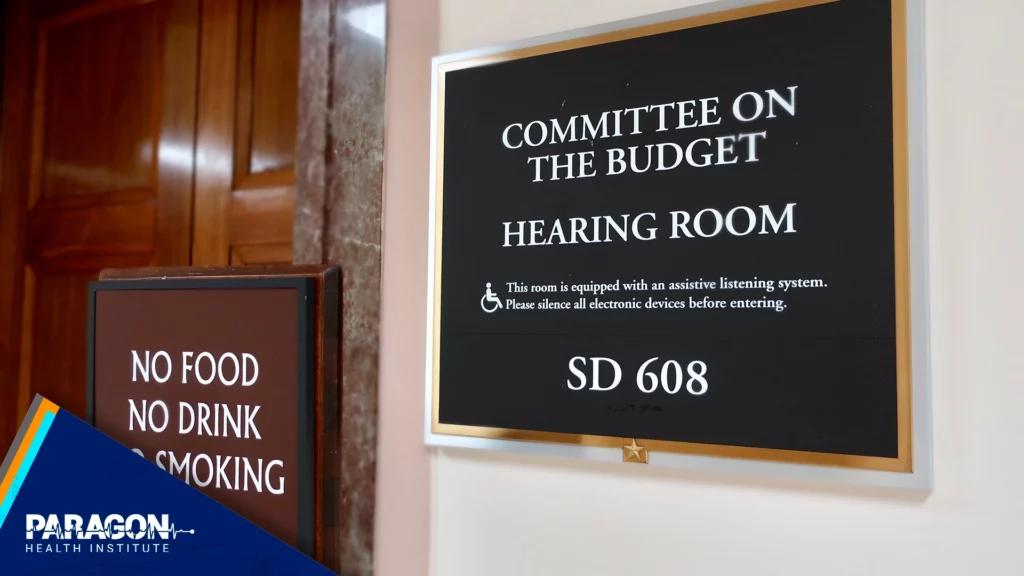On October 18, 2023, Paragon’s Private Health Reform Initiative Director Theo Merkel testified before the United States Senate Committee on the Budget during their hearing, “Improving Care, Lowering Costs: Achieving Health Care Efficiency.”
Thank you, Chairman Whitehouse and Ranking Member Grassley, for convening this hearing and giving me the opportunity to testify.
The growth in health care spending and the value we receive from it is one of the primary domestic challenges facing our nation and perhaps the preeminent issue for any committee tasked with overseeing the federal budget.
The current rate of health care spending growth is unsustainable, for both American families and for the federal government. It is widely acknowledged a significant portion of health care spending does not actually improve Americans’ health, yet well-intentioned but misguided government policies exacerbate wasteful expenditures. Decades of policymakers have sought to avoid the primary factors driving wasteful spending, preferring Washington-driven micromanagement that has failed to bring spending growth to a sustainable rate while distorting the delivery of care and the timing and direction of innovation.
Fortunately, there are numerous steps that Congress can take to slow the unsustainable growth in health care spending while preserving benefits for enrollees in important government programs. However, the longer Congress waits to relearn the lessons of the past, the more difficult the task will become.
The current rate of health care spending growth is unsustainable.
Health care spending has grown relentlessly as a percentage of gross domestic product (GDP) in the modern era, increasing from 5 percent in 1960 to over 18 percent of GDP today.1 Average annual premiums for employer sponsored insurance for a family of four has increased by 45 percent from $15,475 to $22,463 over the past decade.2 The federal government now spends more taxpayer money in health care than any other area, exceeding $2 trillion in 20223 –for context this is now over twice as much as is spent on defense. The Congressional Budget Office (CBO) projects health spending to continue to outpace the overall growth of the economy for the foreseeable future.4
Dedicated revenues such as the payroll tax and premiums cover only a small fraction of these expenditures, with dire implications for the national debt. My Manhattan Institute colleague Brian Riedl has shown that Medicare alone and the interest on the debt to finance it, even after subtracting dedicated revenues, is on pace to add $80 trillion to the deficit over the next 30 years.5 In research for Paragon Health Institute, Paul Winfree applied a model used by the International Monetary Fund to estimate that these deficits would compromise the government’s ability to borrow money within the next 25 to 50 years.6
We do not get a good return for our government’s health care expenditures.
Growth in health care spending can be a good thing if it produces commensurate value for those consuming health care resources. However, research has repeatedly shown that a significant amount of health care spending does not improve health.
For instance, Washington spends more in improper payments for health care, $150 billion last year,7 than proper payments for the Supplemental Nutrition Assistance Program,8 housing assistance,9 or transportation infrastructure.10 A widely cited study by the National Academy of Medicine estimated that 30 percent of all U.S. health spending does not improve health.11
Last year, the Organisation for Economic Co-operation and Development (OECD) released a comparison of health spending in developed nations by type –hospital, physician services, and pharmaceuticals –and confirmed the U.S. spends more on everything.12 Higher spending was due to both higher volumes and higher prices.
Ironically, given last Congress’ action on drug prices, the U.S. spends proportionately less on retail pharmaceuticals than every G7 country but the United Kingdom. This has compounded over the past decade as hospital and physician expenditures have annually averaged over 2 percent growth, adjusted for inflation, while pharmaceutical spending has averaged 0.6 percent. These facts reinforce that the forces driving excess spending are not secluded to one or two types of items or services.
Well-intentioned yet counterproductive government policies exacerbate wasteful spending.
Largely well-intentioned, but ultimately counterproductive government policies inflate inefficient health spending. First, the U.S. is one of the few nations that subsidizes health care largely without limit.
If Medicare is billed for a covered item or service, it will pay it. If a state makes a Medicaid expenditure, Washington will match it. If insurers selling Affordable Care Act plans raise premiums, the federal taxpayer will cover the increase. No matter how generous a health plan an employer chooses, it will receive a tax break.
The contributions that Americans make out-of-pocket to health care, as a percentage of overall health spending, are less than every other G7 nation but France.13 As Milton Freidman noted, the people least likely to carefully seek out value are those who spend other people’s money on people other than themselves.14 This characterizes much of our health care system, with providers determining care for individuals with coverage underwritten partially or entirely by taxpayers. Ultimately, our federal programs end up generously subsidizing care that Americans need, but also subsidizing a lot of inefficient and wasteful care.
Second, in addition to inflating demand with massive subsidies, federal and state policies restrict supply by limiting who can provide health care items and services and where they can provide them. This also insulates providers and suppliers from competition, often allowing them to command higher prices and remain inefficient.15 Furthermore, these policies limit innovation by giving incumbents bureaucratic and political tools to prevent the type of disruption that has been seen in other sectors of the economy.
Top-down reforms such as price controls and the Center for Medicare & Medicaid Innovation have not worked.
With few exceptions, over the past several decades Congress has either exacerbated these two fundamental issues or has directed government technocrats to attempt to mitigate the worst effects. The reason for this hearing today is those efforts have largely failed.
Given its size and importance, Medicare is often the epicenter of the policy debate. Since 1983, price controls have been the technocratic reform of choice, starting with hospitals, moving to physicians, and recently moving to prescription drugs. As applied to the Medicare program, price controls attempt to approximate the cost of providing a service or producing an item and limit reimbursement to that amount plus what is deemed politically to be an appropriate profit margin. As Medicare is the nation’s dominant purchaser, even most private payers use similar payment methods and rates as a starting point in negotiations. There are serious flaws with this approach that has now been the dominant form of reimbursement for forty years.
First, price controls avoid whether or not a service or item should be provided. Importantly, reimbursement tethered to cost inherently promotes innovation that is more expensive as opposed to that which would reduce cost and inevitably receive a lesser rate. This is compounded by procedural aspects of fee-for-service reimbursement, where it is easy to simply add codes for innovations that add cost and difficult to design appropriate reimbursement for innovations that reduce cost.16 In the complex field of medical care with variations in quality, regional patterns of practice, and geographic variations in the distribution of providers, national price controls are bound to distort the delivery of care even if costs could be estimated perfectly17 –which is impossible because the available information is always imperfect despite the best efforts of the Centers for Medicare and Medicaid Services (CMS).
The method of reimbursement and inevitable misvaluing of items and services has implications for the flow of investments. Resources that should be directed to create value for patients and consumers are instead rerouted to opportunities of lesser value but with favored payment or simply arbitrage opportunities created by flawed payment. Finally, the inertia created by requiring change to be approved through bureaucratic or political processes stalls advancement by enormous amounts of time.
Figures 3 and 4 show hospital and physician spending before and after the imposition of Medicare price controls in 1983 and 1992 respectively. While it may be possible to make nuanced claims to the trajectory of Medicare spending or overall spending on these services prior and after imposition, it is impossible to say that this policy lever has made growth in either spending categories sustainable even after decades of refinement. On the other hand, it is possible to conclude with confidence that in the meantime price controls have distorted the delivery of care and the trajectory of innovation to a significant degree, favoring the status quo at the time the policy was adopted.
The Patient Protection and Affordable Care Act (ACA; Public Laws 111-148; 111-152) in part acknowledged the drawbacks of the Medicare price control regime but put faith in a similar top-down approach through which a generously funded new agency of well-intentioned technocrats, insulated from Congressional meddling, would be able to engineer more efficient payment methods. Yet after a decade of work the CBO recently found the Center for Medicare and Medicaid Innovation (CMMI) has added to the deficit.18 Only six out of the 49 models evaluated generated statistically significant savings, and the demonstration that produced the most savings ironically did so through adding administrative costs –prior authorization for non-emergency medical transportation.
Many CMMI demonstrations sought to coax providers and other entities into taking on financial risk–a very worthy goal. Unfortunately, a major lesson of ten years of experience was a quite predictable one: When given the option between financial risk and no risk, providers and other entities prefer no risk.19 The voluntary nature of most CMMI demonstrations left them vulnerable to selection bias –with most participants being those who predicted it would financially benefit them.
There are numerous productive ways to reduce wasteful spending while not reducing benefits for enrollees.
1. Shift financial risk away from taxpayers
To the extent the federal government continues to subsidize health care spending with few or no limits, it will be difficult to incentivize stakeholders to systematically reduce low-value care and constrain health care cost growth over time. Shifting financial risk away from taxpayers does not require shifting it to or limiting protections for enrollees and beneficiaries. Insurers, accountable care organizations, other providers, states, and others can be better positioned to assume risk. In fact, significant progress could be made by just eliminating particularly egregious policies that have actually inflated taxpayer risk relative to original program intent.
Medigap: Traditional Medicare fee-for-service is an outdated benefit with different cost-sharing obligations for separate inpatient and outpatient coverage and no limit to out-of-pocket expenditures for beneficiaries. Enrollees therefore usually opt into Medicare Advantage (MA) plans that have more modern benefit structures or purchase separate wrap-around coverage known as Medigap.
MA plans receive a capitated payment to provide all Medicare Part A and B benefits to enrollees and must also cap overall out-of-pocket liabilities. MA plans may reduce cost-sharing for enrollees but are at risk for additional expenditures. Therefore, there is an incentive to promote care coordination and high value care in cost efficient settings while discouraging low value care.
Medigap plans on the other hand reduce cost-sharing obligations but do not bear the cost of covering the standard Medicare benefits or additional spending that the plan may encourage. A study commissioned by the independent Medicare Payment Advisory Commission (MedPAC) found that enrollment in Medigap increased average Medicare expenditures by 27 percent per enrollee.20
Congress should mitigate incentives to promote excess and low-value spending by Medigap; the CBO has estimated reforming Medigap design would save $100 billion over seven years.21
Medicaid and provider taxes: Medicaid is jointly financed by the federal government and states, with state expenditures being matched by federal payments at rates set under law. On average, the federal government reimburses about two-thirds of state Medicaid expenditures. States have primary oversight over Medicaid expenditures, and in theory federal exposure to wasteful spending should be limited by the shared obligation of states to finance the program.
Unfortunately in practice, states utilize financing gimmicks to minimize their actual program expenditures, essentially receiving federal reimbursement on illusory state contributions.22 This undermines the program design and leaves federal taxpayers at significant risk for wasteful or excessive Medicaid expenditures–not to mention schemes where federal Medicaid dollars effectively go to non-health expenditures.23 The CBO has estimated it would save federal taxpayers $500 billion over the next decade to limit just one financing scheme by ending the safe harbor that allows states to tax providers and then return that equivalent amount in Medicaid payments up to 6 percent of net patient revenue.24
2. Get the government out of the business of dictating who should be paid how much and where
Many of the ways that price controls and barriers to entry distort care and increase prices are difficult to see. For instance, consider a hypothetical scenario where an investment could be made in a competitor to a high-priced hospital, but the project requires political approval through Certificate of Need. Instead, the investment goes to a safer bet to expand a clinic that specializes in a procedure with a Medicare price that has not been adjusted downward to reflect recent advancements in productivity. These types of distortions happen every day impacting how care is provided, which investments are made, and even what careers Americans pursue, but are largely unseen and are often impossible to quantify.
In other cases, distortions are more obvious and observable. Medicare will pay a different rate for the same service depending on the setting where care is provided. Over time research has shown hospitals take advantage of this payment differential, purchase lower cost physicians’ offices, and convert them into outpatient departments that then provide the same service at a higher price.25
Similarly, certain providers receive Congressionally mandated discounts on outpatient prescription drugs through the 340B program yet continue to charge payers, including Medicare, a higher price. Research26 has repeatedly27 shown that 340B eligible hospitals “have an incentive to increase margins by expanding their patient base” and purchasing oncology practices and other office-based providers.28
While a whole scale reevaluation of the current price control regime and barriers to competition would be beneficial, Congress can take incremental steps in the meantime to limit obvious flaws.
Site neutral payment: There have been various positive proposals put forth to eliminate or reduce payment disparities for certain services across care settings, summarized recently in a policy brief by Joe Albanese of Paragon Health Institute.29 This includes proposals to equalize Medicare Part B drug payment across doctor’s offices and hospital outpatient departments as included in the Lower Costs, More Transparency Act jointly introduced by the House Energy and Commerce, Ways and Means, and Education and Workforce Committees. Ideally Congress would pursue even more wide-reaching reforms such as the policy considered in an Energy and Commerce Committee discussion draft that would equalize payment for a wide range of services across hospital outpatient departments, ambulatory surgical centers, and physicians’ offices.
Medicare and 340B: As Brian Blase of Paragon Health Institute and I recently summarized in a comment letter to CMS:
“[Outpatient Prospective Payment System] payment for 340B drugs is flawed. Despite 340B-covered entities receiving discounts of 25 to 50 percent on drugs, Medicare and its beneficiaries pay the same rate for these as for other drugs (there also is no legal requirement to pass along these savings to needy patients).”30
In 2017, CMS finalized a rule that reduced Medicare payment to the cost of procurement under 340B, annually saving $1.6 billion in total drug payments including $320 million in reduced beneficiary cost-sharing. Unfortunately, the Supreme Court invalidated the policy over procedural concerns. While CMS still has the ability to accommodate the Court’s concerns in a revised rule, Medicare requires that certain regulatory changes be done in a budget neutral manner. This would result in Medicare savings on drug payments translating into higher payments throughout the Part B fee schedule. As recommended in Paragon Health Institute’s report “Turning the Tide on Red Ink,” Congress should enact this 340B reform in statute and save taxpayers and beneficiaries billions over the next decade.31
3. Favor bottom-up solutions instead of top-down approaches that have repeatedly failed over time
Well-intentioned technocrats in Washington will never be as motivated to seek value as those with well-aligned incentives such as patients, providers, employers, or others who bear financial risk. Congress should take action to give these Americans the tools to make value conscious decisions in health care.
Increasing coverage options: The ACA significantly limited what types of private health insurance Americans can buy and provided large subsidies for those that meet certain income thresholds without an alternative source of coverage. The results have been underwhelming, with a recent actuarial analysis from Paragon Health Institute showing the policy changes prompted by the law have led to half the anticipated coverage gains in private insurance at three times the projected cost per new enrollee.32 The exchanges appear to have reached a steady state of enrollment, where less than 20 percent of enrollees purchase coverage completely with their own money. However, ensuring the availability of lower cost, quality options outside of the ACA can allow more individuals to obtain insurance coverage if ineligible for premium subsidies.
To this end, Congress should prevent the current Administration from restricting the availability of short-term limited-duration insurance contracts to just three months from the current length of 364 days with an option to renew up to three years. The misguided proposed rule would remove flexible coverage options, strip coverage from the sick, and increase the number of uninsured.33 Furthermore, there is no evidence that availability of these coverage options has led to a deterioration in the availability or the price of ACA plans.34
Congress could also make significant progress expanding coverage options for small businesses. Only 32 percent of small businesses offer insurance coverage to their employees, down from 45 percent in 2002. Currently, small businesses can join together for the purpose of providing health insurance if there is a commonality of interest. This provides regulatory advantages and economies of scale that enable lower cost, quality coverage. However, current opportunities are limited by a narrow regulatory interpretation. As Kev Coleman explains in a Paragon Health Institute issue brief, “a group of carpentry firms may qualify…but a homebuilder group composed of carpenters, electricians, plumbers, and painters would not.”35 Congress should relax the definition of commonality of interest and revisit the conditions to allow any employer, including sole proprietors, within a state or metropolitan area to join together for the purposes of offering health insurance.
Price transparency: Public policy experts have long claimed that health care is “different” than almost every aspect of the American economy, immune to the normal feedback loop where the value of goods and services is established by numerous, repeated, and ongoing voluntary transactions between consumers and suppliers. Over decades, some of the same experts successfully advocated for policies –namely third-party payment, high barriers to entry, and robust government subsidization –that reinforced the same outcome they predicted. The result has been a U.S. health care system almost engineered to be opaque, preventing individuals from seeking out the cost of care even if they were motivated to do so.
Surveys have shown unambiguously that Americans want to know the price of care before it is rendered.36 Research has demonstrated that in the rare instances when motivated shoppers have pricing information, they are able to obtain cost savings.37 Research by Larry Van Horn and others has demonstrated the magnitude of the opportunity, with significant price variation for services within regions and cash alternatives that average 40 percent lower than prices negotiated by commercial insurers.38
The Trump Administration launched a significant initiative to require hospitals and insurers to publicly post prices, including payer specific negotiated rates.39 Fully implemented, the potential impact could save tens of billions of dollars per year in the commercial market alone, according to a recent analysis by Stephen Parente.40 However, compliance with the rules as of the date of this testimony is underwhelming. The House of Representatives has begun to consider legislation that would codify and improve upon these important transparency regulations. The Senate should follow suit, with special attention given to enhancing compliance.
These are just a few opportunities Congress has before it to improve the value of health care spending. Thank you again for the opportunity to testify, and I look forward to your questions.
Full hearing video:
Video starting from Theo’s testimony:









